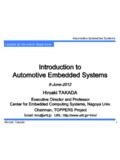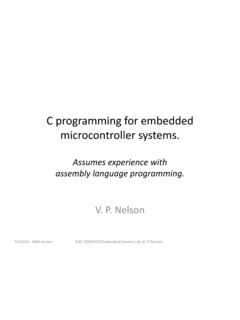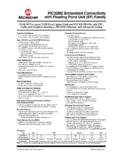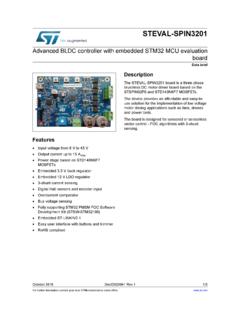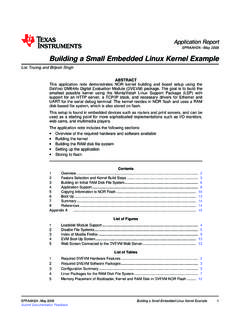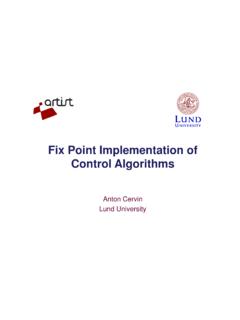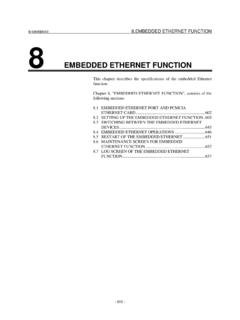Transcription of Embedded low-power deep learning with TIDL - …
1 Embedded low-power deep learning with tidl . Manu Mathew Principal Engineer &. Member Group Technical Staff Kumar Desappan Member Group Technical Staff Pramod Kumar Swami Principal Engineer &. Member Group Technical Staff Soyeb Nagori Senior Principal Engineer &. Senior Member Technical Staff Biju Moothedath Gopinath Engineering Manager Automotive Processors Texas Instruments Introduction Computer-vision algorithms used to be quite different from one another. For example, one algorithm would use Hough transforms to detect lines and circles, whereas detecting objects of interest in images would require another technique such as histograms of oriented gradients, while semantic segmentation would require yet a third type of algorithm.
2 deep learning methods, including convolutional neural networks (CNNs), have revolutionized machine intelligence, helping algorithms become more accurate, versatile and autonomous. deep learning has also revolutionized automotive applications. Many state-of-the-art algorithms for advanced driver assistance systems (ADAS) now require deep learning methods, including the detection of lane markings and the detection and classification of various objects such as pedestrians, vehicles, cyclists and traffic signs. deep learning has emerged as a key technology that provides the best accuracy for most of these algorithms.
3 The tools described in this paper help enable ADAS algorithms on automotive processors from Texas Instruments (TI). deep learning provides a systematic way to enable a variety of algorithms. For example, deep learning configurations for many algorithms operate quite similarly, making deep learning a perfect candidate to accelerate processing speeds through software- and hardware-optimization techniques. In this paper, we will specifically address software optimization: highly optimized software components that maximize the efficiency of the available hardware and can increase the speed at which deep learning algorithms run.
4 Algorithmic optimization involves developing faster algorithms to achieve the same end result faster or better. Providing libraries and components that are easy to use and integrate into existing system frameworks improve time to market. These are the goals of the tools we'll describe in this paper. TI's Jacinto TDA2, TDA2P and TDA3 automotive algorithms for automatic emergency braking or processors enable the processing and fusing of driver monitoring, as well as stitching multiple data from camera, radar and ultrasonic sensors camera streams together for surround views.
5 [1]. to support ADAS functionality . These sensors Other algorithms include lane detection for lane- enable object detection, classification and tracking keep assist and the detection of 3-D structures for Embedded low-power deep learning with tidl 2 January 2018. parking assist. These processors can also perform object-classification algorithms that operate on a semantic segmentation, which can help identify the small region of interest in the image. free space available for driving by classifying which pixels of an image belong to the road and which deep learning for low-power devices pixels do not.
6 deep learning involves training and inference. TI deep learning ( tidl ) is a suite of components that Training usually occurs offline using a large data enables deep learning on TI Embedded devices. set on servers or PCs with external graphics tidl has a highly optimized set of deep learning processing units (GPUs). Real-time performance or primitives that provide the best accuracy, speed and power is not an issue during this phase. However, memory usage trade-offs. It also provides an easy during actual inference, when a low-power device way to use a model from one of the popular deep - executes an algorithm such as lane detection, learning training frameworks and run it on a TDA- real-time performance and power consumption are based Embedded platform very quickly.
7 Ease of use important. Several publicly available deep learning and high performance are the two key motivations frameworks enable the training of CNN or other behind tidl . deep learning models. Popular frameworks include Caffe, TensorFlow, CNTK, MxNet and PyTorch. Figure 1 illustrates the tidl suite of components. The first part of the development flow is for training Most of these platforms are optimized for central a network model and is best accomplished within processing units (CPUs) or GPUs and run at very popular training frameworks. The next step is using high speeds, especially on the GPUs.
8 However, the tidl device translator tool to convert network there is a lack of support for low-power Embedded models into an internal format best suited for devices such as digital signal processors (DSPs). use inside the tidl library. The final step is to run Because DSPs consume much less power than the converted network model on the Embedded GPUs, systems using DSP processors can be TDA device using tidl -provided application placed in small cases that provide limited thermal programming interfaces (APIs). dissipation or in portable devices that have limited battery power .
9 tidl can run full-frame CNNs, which some of the ADAS algorithms, such as object detection and TI developed the tidl suite of components in order semantic segmentation, require. tidl can also run to address the gap for supported DSPs. tidl does not address the training deep learning /CNN training TI device translator tool tidl of deep - learning models, TI deep learning which the popular deep - library ( tidl ). Caffe learning frameworks can OpenVX. TensorFlow TI device translator tool framework best handle. Instead, (format conversion). TDAx tidl addresses the Caffe-Jacinto Processor inference part of deep learning , using a trained model from a supported Training Format conversion Inference deep learning application (PC/GPU) (PC) ( Embedded device) network and running it at Figure 1.
10 tidl development flow. a very high speed on a Embedded low-power deep learning with tidl 3 January 2018. supported low-power Embedded processor like one that runs faster when using sparse models. from the TI TDA family. Speed-up can be quite significant when sparsity The TI device translator tool enables development is high. on open frameworks and provides push-button Quantized inference and on-the-fly PC-to- Embedded porting. tidl abstracts quantization. The trained model is a floating- Embedded development, provides high-efficiency point model. However, floating point is not implementation and is platform scalable.










